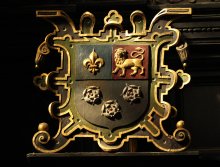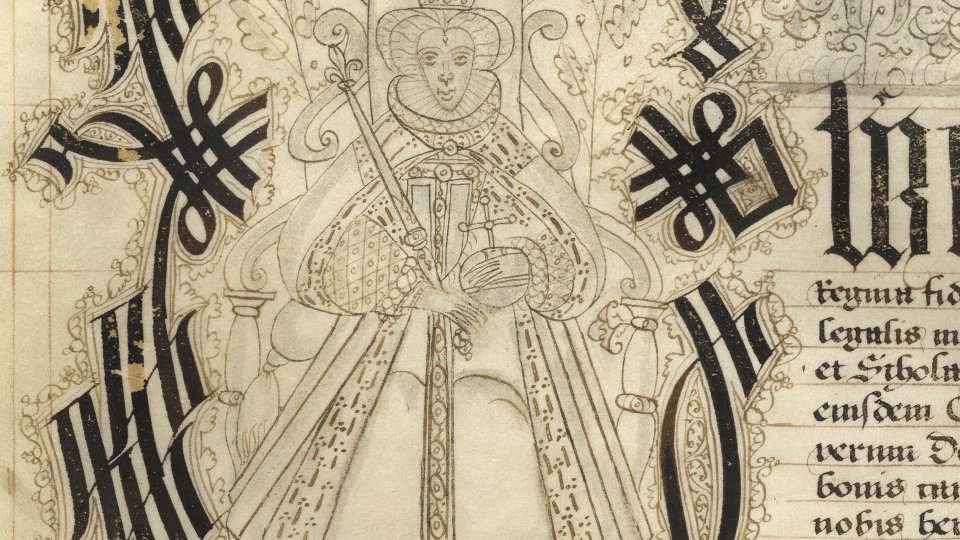Both the role the organ has played in the Chapel and its aesthetic have changed significantly throughout the College’s history. During its somewhat turbulent history, it has been reconditioned, repositioned, decommissioned and replaced. It now commands a central position in the Chapel, both literally and figuratively. Its distinctive sound is frequently heard at services and recitals held in the Chapel.
The organ has undergone many changes, in terms of repairs and replacement, as well as its location and use. By 1452 the original College Chapel was furnished with two modest organs, one ‘great’ and one small. Until the mid-16th century their purpose was not to accompany the choir so much as to respond in solo to the Choir. Now it is a central part of the College's liturgical and musical life.
|
29 Sep 1441 |
Foundation stone of original chapel was laid, between the Old Court and the site of the current Chapel. Eventually two organs were in use in this chapel. |
|
25 July 1446 |
The foundation stone of the present Chapel was laid on the feast of St James, by the King. The original chapel remained in use. |
|
1451 |
Records show that organs were repaired in 1451 and throughout the following decade. |
|
1452 |
Chapel equipped with books of chant and polyphony, as well as a pair of organs. |
|
1507-8 |
New organ by Thomas Brown, £48 |
|
1515 |
Completion of stonework of the current King’s College Chapel |
|
1537 |
Both organs moved to the new (present) Chapel when the original College Chapel collapsed. Around this time, the organ was used to substitute for music that which might otherwise be sung. It did not provide musical accompaniment to the Choir. |
|
1564 |
Queen Elizabeth visited the Chapel and heard a Te Deum ‘solemnly sung in Prick Song … the organs playing’. |
|
1570 |
Provost Goad sold the great organ. |
|
1602 and 1604 |
College visitor rules on the 1570 sale. |
|
1606 |
John Tomkins appointed the first Organist and Master of the Choristers |
|
c.1607-11 |
John Smythson plan of the Chapel shows the organ placed at ground level in the Choir. |
|
1613 or 1630 |
Organ probably moved from the East End to the top of the screen in anticipation of the royal visits of 1613 or 1632. |
|
c.1650 |
Dallam organ sold except for inner case, obeying a Parliamentary Ordinance. |
|
1661 |
Chair organ by Lancelot Pease installed on the screenin addition to the great organ, for £200 |
|
1673-7 |
A ‘loftier organ’ built by Thomas Thamar, probably a new organ in the old great organ case atop the screen |
|
1688 |
New organ by Rene Harris, £350. |
|
1803-5 |
John Avery reconstructed and enlarged the organ, incorporating the first pedal pipes |
|
1859 |
William Hill and Son enlarged the organ, more than doubled the case depth, preserved the ancient appearance of the front and added angels to the case |
|
1888 |
Organ redesigned including tubular-pneumatic action and water power |
|
1933-4 |
Organ thoroughly overhauled by Harrison and Harrison, following consultation with Boris Ord (Organist). |
|
1950 |
Minor changes, including the addition of a Pedal Fifteenth and Mixture |
|
1968 |
Major overhaul including re-leathering, the replacement of the ‘great’ power motors, and addition of six new stops. |
|
1992 |
Essential repairs |
|
2003 |
Essential repairs, including replacement of the pedal board, leak repairs and pipework |
|
2009 |
Harrison & Harrison reconditioning of the front pipes, some internal pipework and the console. |
The first statute of King’s College’s earliest statutes, written in Latin in 1443, states that at least one of the chaplains or chapel clerks must be able to play an organ.
The College’s accounts record the sale of the organ by Provost Goad, in 1570-71. One hundred shillings was paid for the organ (‘pro Organis’), while 45s 10d was paid for the old pipes (‘for thold organ pipes’).
Following Provost Goad’s sale of the organ, Fellows cited the first statute in their objections to the Visitor in 1603:
42. By ye first statute organs are required, but we have them not nowe, but solde those wch we had by our Founder. (KCV/49, f.64, no. 42.)

While Dallam and his men worked in the Vestry, creating their organs, ‘Hartop the Joyner’ and his men worked in the Chapel, preparing the organ case and the timber frame upon which the organ was to stand, to which ‘Chapman the Joyner’ added panelling. Hartop’s work took ten months, after which a carver was paid to add the royal arms and escutcheons of King’s College and Eton College. ‘Knockle the Limber’ was paid to decorate the carved work and pipes, using gold leaf and coloured paints, beginning with the chair organ.
There has been considerable debate concerning the date of the organ cases. The general consensus is that the majority of the work dates from 1688, but some have suggested that parts remain from Dallam’s time. John Saltmarsh has noted the similarity of carvings between those described in the case Hartop created for Dallam’s organ in 1605-6, though he notes that they would have been positioned differently and coloured or gilded. For example, there were crowns on the case of Dallam’s chair organ and crowns surmount the two outer towers of the present chair organ. He also suggested that two figures which were carved for Dallam’s great organ case may be the two satyrs found on the current case. The two scutcheons of arms of King’s College and Eton College may also have been retained; however, if that is the case, they were moved from the chair organ case to the great organ case. Saltmarsh conceded that if these features weren’t retained from the 1605 organ cases, Renatus Harris may have been influenced by the Dallam organ.
Initially the Master over the Choristers was in charge of educating the choristers, and the Precentor was in charge of satisfactory performance of all aspects of chapel worship including the music. These offices were elected annually. At least one Chaplain or Lay Clerk had to be able to play the organ, a statutory requirement of the College.
From 1603 the College focussed on reinstating organs in worship and the first person to hold the position of Organist on an official basis – the position was sometimes combined with that of Master over the Choristers – was John Tomkins.
Just as the organ has undergone changes, so have the role and title of Master over the Choristers. First, they became known as the Organist, then they became the Director of Music.
This complete list of Organists is remarkably short for an office 400 years old.
|
1606 |
John Tomkins – later Organist at St Paul’s, son of Thomas Tomkins (Organist of Worcester Cathedral and a scholar of Bird) |
|
1622 |
Matthew Barton |
|
1625 |
Giles Tomkins – brother of John Tomkins |
|
1626 |
? Marshall |
|
1627 |
Henry Loosemore |
|
1671 |
Thomas Tudway – dismissed and deprived of his College and University posts in July 1706 for insulting the queen, restored the following March after recanting |
|
1728 |
Robert Fuller – Lay Clerk turned Organist, who died very soon after and was succeeded by his son Wendy Fuller |
|
1743 |
John Randall |
|
1800 |
John Pratt – held the office of Organist until his death, age 83; the last Organist also to be Master over the Choristers |
|
1855 |
William Amps – victim of College reform |
|
1876 |
Arthur Henry ‘Daddy’ Mann - is believed to have been the first College organist to be elected (near the end of his life) to a Fellowship. His appointment was the first time that the job was filled by open competition. |
|
1929 |
Bernhard ‘Boris’ Ord – Organist until the post Director of Music was created for his last years |
|
1957 |
David Willcocks – Organist, then Director of Music |
|
1974 |
Philip Ledger |
|
1982 |
Stephen Cleobury |
During World War Two, Harold Darke stood in for Boris Ord. His contribution to the musical life of the College was noteworthy, as he initiated the Saturday post-service organ recitals which continue to this day.
Having secured a good organ and talented organists, the College had to ensure that the music played on it was befitting such a prestigious and acoustically difficult setting as King’s College Chapel. Responsibility for this lay with the Organists, who often marked special occasions, joyous or solemn, with music to suit the mood. They also permitted others to play the organ, when appropriate. They celebrated and memorialised, though their choice of harmonies, always choosing the right note. They saw the organ as an instrument which could be used for more secular amusement, as well as religious observation, introducing recitals.
They also recognised when silence was more appropriate. When a Fellow or Provost died, the organ was not to be played until their funeral had taken place, as noted in a book of instructions and notes on the choir, started by John Pratt and continued by William Amps, between 1799-1855.
The service of dedication of the College’s First World War Memorial, which included poems by Rupert Brooke, took place on 2nd November 1921. The Organist set the tone for the occasion. A note by ‘Daddy’ Mann at the front of the organist’s order of service reads:
A quarter of an hour before the Service the organist plays an appropriate piece (e.g. Bach’s Prelude on the chorale “Schmücke dich”) lasting about 7 minutes. One minute before the service the organist improvises in G minor finishing when the verger pulls the pendulum in the chord of G minor.
